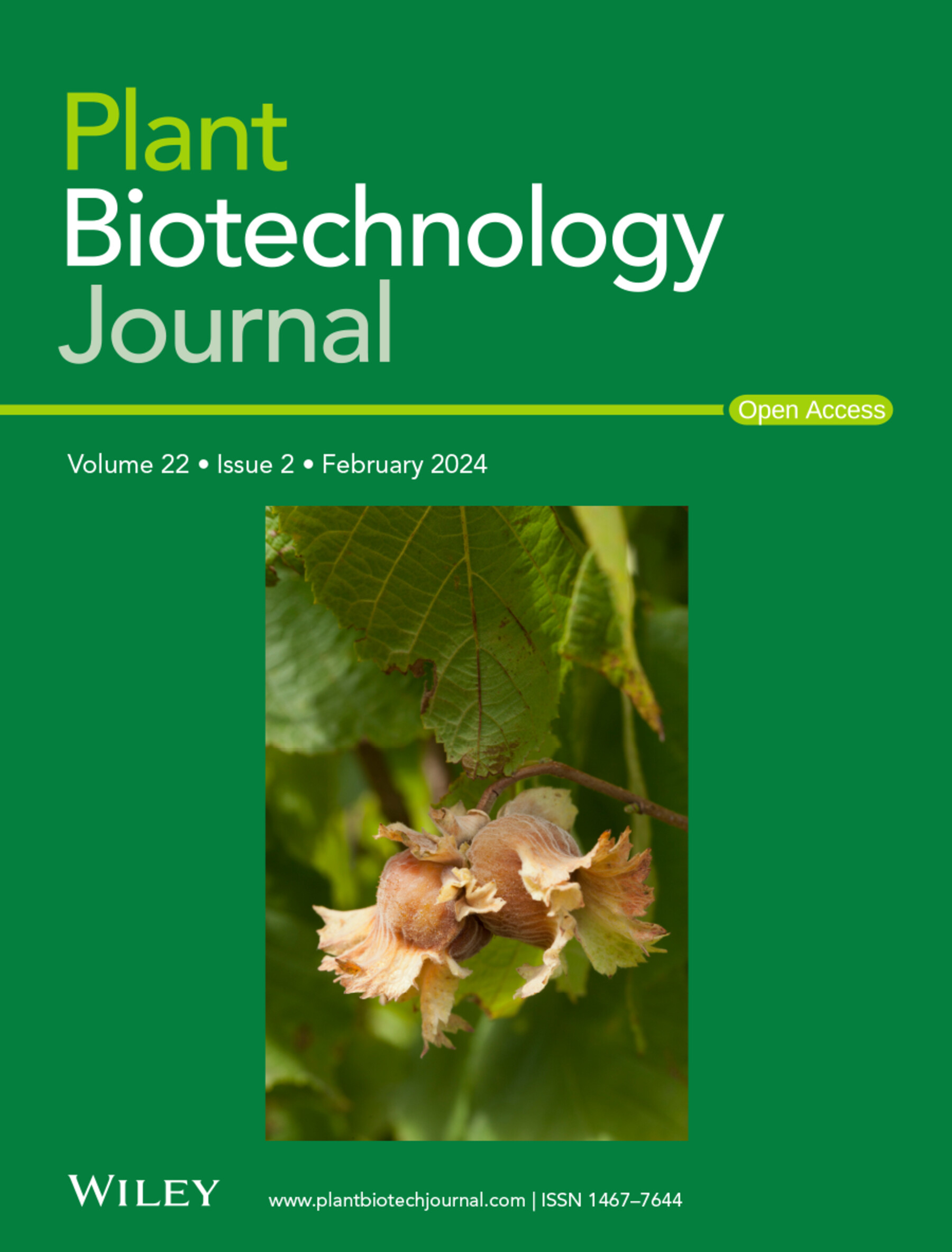r2r3型MYB转录因子GmMYB77负向调控大豆异黄酮积累稳定)
IF 10.1
1区 生物学
Q1 BIOTECHNOLOGY & APPLIED MICROBIOLOGY
引用次数: 0
摘要
大豆[甘氨酸max (L.)]稳定。是一种异常丰富的异黄酮,这些化合物附着在人体内的雌激素受体上,降低了患乳腺癌的风险,有效地缓解了更年期综合症的症状。揭示调控大豆异黄酮积累的分子机制对于促进这些化合物的产生至关重要。在本研究中,我们结合大规模分离分析测序(BSA-seq)和全基因组关联研究(GWAS)发现了一个新的调控大豆异黄酮积累的R2R3-MYB家族基因GmMYB77。利用大豆毛状根瞬时表达系统,验证了GmMYB77对大豆异黄酮积累的抑制作用。敲除GmMYB77显著提高了总异黄酮(TIF)含量,其中以丙二酰甘油含量最高,而过表达GmMYB77导致丙二酰甘油和TIF含量显著降低。通过双荧光素酶测定、电泳迁移位移测定和酵母单杂交实验发现,GmMYB77可直接结合核心序列GGT,抑制关键异黄酮合成基因异黄酮合成酶1 (GmIFS1)、异黄酮合成酶2 (GmIFS2)、查尔酮合成酶7 (GmCHS7)和查尔酮合成酶8 (GmCHS8)的表达。GmMYB77启动子区域的自然变异会影响其表达,从而调节丙二醛甘油三酯和TIF含量。Hap-P2是一种优秀的单倍型,在大豆育种中起着关键作用,能显著提高大豆异黄酮含量。这些发现增加了我们对大豆异黄酮含量影响基因的认识,为今后的分子育种工作提供了宝贵的遗传资源。本文章由计算机程序翻译,如有差异,请以英文原文为准。
An R2R3-type MYB transcription factor, GmMYB77, negatively regulates isoflavone accumulation in soybean [Glycine max (L.) Merr.]
Soybean [Glycine max (L.) Merr.] is an exceptionally rich in isoflavones, and these compounds attach to oestrogen receptors in the human body, lessening the risk of breast cancer and effectively alleviating menopausal syndrome symptoms. Uncovering the molecular mechanisms that regulate soybean isoflavone accumulation is crucial for enhancing the production of these compounds. In this study, we combined bulk segregant analysis sequencing (BSA-seq) and a genome-wide association study (GWAS) to discover a novel R2R3-MYB family gene, GmMYB77, that regulates isoflavone accumulation in soybean. Using the soybean hairy root transient expression system, we verified that GmMYB77 inhibits isoflavone accumulation. Furthermore, knocking out GmMYB77 significantly increased total isoflavone (TIF) content, particularly malonylglycitin, while its overexpression resulted in a notable decrease in contents of malonylglycitin and TIF. We found that GmMYB77 can directly binds the core sequence GGT and suppresses the expression of the key isoflavone biosynthesis genes Isoflavone synthase 1 (GmIFS1), Isoflavone synthase 2 (GmIFS2), Chalcone synthase 7 (GmCHS7) and Chalcone synthase 8 (GmCHS8) by using dual-luciferase assays, electrophoretic mobility shift assays and yeast one-hybrid experiments. Natural variations in the promoter region of GmMYB77 affect its expression, thereby regulating the malonylglycitin and TIF contents. Hap-P2, an elite haplotype, plays a pivotal role in soybean breeding for substantially enhanced isoflavone content. These findings enhance our understanding of the genes influencing soybean isoflavone content and provide a valuable genetic resource for molecular breeding efforts in the future.
求助全文
通过发布文献求助,成功后即可免费获取论文全文。
去求助
来源期刊

Plant Biotechnology Journal
生物-生物工程与应用微生物
CiteScore
20.50
自引率
2.90%
发文量
201
审稿时长
1 months
期刊介绍:
Plant Biotechnology Journal aspires to publish original research and insightful reviews of high impact, authored by prominent researchers in applied plant science. The journal places a special emphasis on molecular plant sciences and their practical applications through plant biotechnology. Our goal is to establish a platform for showcasing significant advances in the field, encompassing curiosity-driven studies with potential applications, strategic research in plant biotechnology, scientific analysis of crucial issues for the beneficial utilization of plant sciences, and assessments of the performance of plant biotechnology products in practical applications.
 求助内容:
求助内容: 应助结果提醒方式:
应助结果提醒方式:


